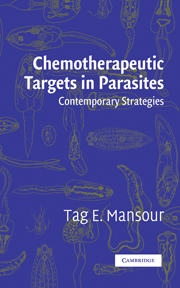Book contents
- Frontmatter
- Contents
- Preface
- Acknowledgments
- 1 The Search for Antiparasitic Agents
- 2 Biophysical, Genomic, and Proteomic Analysis of Drug Targets
- 3 Energy Metabolism in Parasitic Helminths: Targets for Antiparasitic Agents
- 4 Antimalarial Agents and Their Targets
- 5 Antitrypanosomal and Antileishmanial Targets
- 6 Targets in Amitochondrial Protists
- 7 Neuromuscular Structures and Microtubules as Targets
- 8 Targets in the Tegument of Flatworms
- Epilogue
- Index
- References
7 - Neuromuscular Structures and Microtubules as Targets
Published online by Cambridge University Press: 11 August 2009
- Frontmatter
- Contents
- Preface
- Acknowledgments
- 1 The Search for Antiparasitic Agents
- 2 Biophysical, Genomic, and Proteomic Analysis of Drug Targets
- 3 Energy Metabolism in Parasitic Helminths: Targets for Antiparasitic Agents
- 4 Antimalarial Agents and Their Targets
- 5 Antitrypanosomal and Antileishmanial Targets
- 6 Targets in Amitochondrial Protists
- 7 Neuromuscular Structures and Microtubules as Targets
- 8 Targets in the Tegument of Flatworms
- Epilogue
- Index
- References
Summary
Parasites' ability to control their motility in their specific natural location in the host is critical to their survival. For example, Ascaris living in the small intestine of the host mammal have to move very vigorously to maintain their position and avoid expulsion with the flow of the intestinal contents. Any interference with coordination of the parasites' movements could result in their being carried to the large intestine, an environment that is hostile to Ascaris survival. Certain antiparasitic agents owe their effect to a selective inhibition of the motility of the parasites. These drugs can eliminate intestinal parasites as a consequence of their interference with the motility needed to maintain the parasites' position in the host.
Neuromuscular Physiology of Nematodes
Because of its large size and ready availability Ascaris suum is generally used as a prototype organism representing nematodes. It is generally accepted that there is a close relationship between the neuromuscular morphology and physiology of the free-living nematode C. elegans and Ascaris. For this reason C. elegans is frequently used as a prototype organism for experiments that involve genetic analysis or molecular biological manipulation. However, Ascaris has larger cells that are easier to access for electrophysiological experiments, such as electrode voltage clamp recordings. Pharmacological preparations made from portions of an intact Ascaris were used to measure muscle contractility by Baldwin as early as 1943 (Baldwin, 1943).
- Type
- Chapter
- Information
- Chemotherapeutic Targets in ParasitesContemporary Strategies, pp. 156 - 188Publisher: Cambridge University PressPrint publication year: 2002
References
- 1
- Cited by



